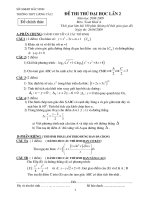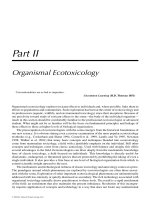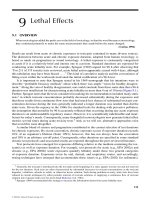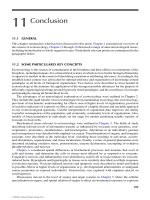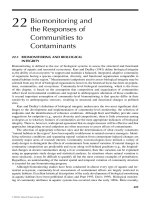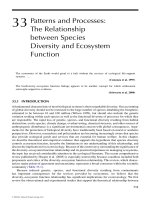LANDSCAPE ECOLOGY A Top-Down Approach - Chapter 2 docx
Bạn đang xem bản rút gọn của tài liệu. Xem và tải ngay bản đầy đủ của tài liệu tại đây (204.71 KB, 15 trang )
2
An Epistemology of Landscape Ecology
Jim Sanderson and Larry D. Harris
CONTENTS
Definitions
Ecological Theories
Examples of Landscape Ecological Studies
A Note on Chaos Theory
Huffaker Revisited
Huffaker ’s Conclusions
Modern Interpretation
Exercises
We all think we know much about the natural world. We hear, feel, see, taste,
and smell parts of the world around us nearly continuously. Furthermore, we
all accept that with knowledge of the present and the past coupled with
induction, we could generate new knowledge about the future. Obviously,
since the sun has risen in the east at least since the time of recorded history,
the sun will most likely rise in the east tomorrow. But is this enough? How
do we know when something is true? Must we prove something is true
before we accept it as fact? What is the source of knowledge and can we
develop a theory of human knowledge? The philosophical examination of
human knowledge is referred to as epistemology (Encyclopedia Americana
1994). As a division of philosophy, epistemology is the study of the origin of
knowledge and attempts to develop a theory of the nature of knowledge
(American Heritage Dictionary 1985).
As scientists, ecologists attempt to explain scientific facts and observations
concerning ecology and to create theories that suggest new and novel facts or
observations. That is, based on a set of observations, ecologists attempt to
suggest further observations that have not yet been made. A theory is created
based on a finite set of observations and then used to predict new observations that can be made that have not been made before. If the theory is sound,
these new observations will be correctly predicted. A scientific theory in ecology can never be proved by observations, but can be disproved by only one
© 2000 by CRC Press LLC
observation. Indeed, the most dangerous threat to a new theory is newer
data. Thus, the science of ecology advances not by proving new theories, but
by disproving already existing theories. To provide a sound basis for our
investigations we must develop landscape ecology as an epistemological
paradigm. We follow Scheiner et al. (1993), but change their pattern of linkages between ecological entities to better suit our needs. If the objects, processes, and theories can be woven together into a tight fabric, a solid
theoretical basis for making predictions will result.
Definitions
The four basic elements of the epistemology are entities, processes, properties,
and theories and these must be defined (Scheiner et al. 1993). Entities are
objects or groups of objects. An individual, a population of individuals, a
community, and an ecosystem are examples of entities. Entities can have subentities. For instance, a community can consist of numbers of individuals of
different species. Abiotic resources can be an entity. Entities are linked by processes that are interactions between objects. The uptake of nutrients between
the soil and green plants is an example of a process. Herbivory, predation,
mutualism, and movement are examples of processes.
A property is a characteristic of an entity. Properties of entities are familiar
to all of us. For instance, one molecule of oxygen when bonded with two molo
o
ecules of hydrogen is a solid at or below 0 C, a liquid between 0 and 100 C,
o
and a gas above 100 C. The process of heating the entity causes the state to
change from a solid to a liquid and then to a gas. Here we must know the context of the molecule to appreciate its form. Individuals have properties such
as the ability to fly, populations migrate occasionally, communities such as
wiregrass and longleaf pine are thought to form an association that promotes
the process of fire, and ecosystem properties are defined by the process of
energy flow and the cycling of materials. Landscapes too have properties.
Recalling our definition that a landscape is two or more ecosystems, landscapes can support species that require forage in a grassland ecosystem and
cover in a forest ecosystem.
We accept Bissonette’s (1997, pp. 17–23) definitions of collective and emergent properties. Briefly, if a property can be explained fully by mechanisms
examined at the next lower level of complexity, then the property is collective, otherwise it is emergent. Epistemological questions such as whether
complex systems exhibit emergent properties can be resolved as a matter of
definition (Dobzhansky et al. 1977). We cannot tell whether water is a solid,
liquid, or gas simply by examining a molecule of oxygen and two molecules
of hydrogen, for instance. Landscape processes such as fragmentation are
obvious to many of us, but we consider the effect fragmentation has on
© 2000 by CRC Press LLC
organisms to differ from the top-down forces organisms have on the landscape.
A theory is a model of how a process acts on an entity to determine the
properties of the entity. An example of a relatively new theory is that the sun,
as opposed to the earth, is at the center of the solar system. Until 400 years
ago, humans believed that the earth was the center and that the sun and other
planets revolved around the earth. The new model based on the process of
gravity seems to better explain the orbital properties of certain entities called
planets, especially those now believed to be beyond the orbit of the earth.
This new theory cannot be proved, but is now widely accepted by everyone
— as was the previous theory. Theories can be inductively or deductively
deduced.
Deductive reasoning is the process of inferring from the general to the specific. Lindeman (1942), after his fieldwork on small Cedar Bog Lake near the
University of Minnesota, deduced that the lake was an entity called an ecosystem that could be described as a network of processes or interactions
within groups of subentities called organisms linked by the process of feeding and contained within the ecosystem. Lindeman described the interaction
between the biotic and abiotic entities of the lake envisioned by Forbes (1887)
and others. The lake ecosystem through its subentities took in energy from
the sun and nutrients and recycled them into insects and food for terrestrial
animals.
Lindeman’s theory asserted that nature was organized into ecological systems that were recognizable objects such as lakes that have an origin and
development leading to a steady state or dynamic equilibrium. These systems, Lindeman asserted, have a structure defined as a network of feeding
relationships among their species populations that can be simplified by
grouping the populations into food chains or trophic levels. An ecosystem
process, beyond development through time, was that energy received from
the sun went into heat and work to process chemical elements. The structure
and function of the ecosystem was expressed mathematically as a series of
equations describing the interactions between system components. Lindeman claimed, for instance, that the ratio of transfer up the food pyramid varied from 10 to 22.3% depending on the trophic level. Lindeman, 7 years
following Tansley’s definition of an ecosystem, provided an example and
stated a theory that enabled testing of hypotheses and hence defined a program that occupied ecologists for the next 40 years (Golley 1993). Such was
the power of Lindeman’s Trophic–Dynamic Theory.
Inductive reasoning allows generalization of a class after reasoning about
a particular member of the class. For instance, if we observed that all swans
in a particular lake were white we might induce that all swans everywhere
were white and propose the White Swan Theory. Further observations allow
testing hypotheses derived from the theory. Note that only one counterexample is needed to show the theory is incorrect. Thus, induction is the process
of creating hypotheses from observations (Briggs and Peat 1984).
© 2000 by CRC Press LLC
Ecological Theories
Though we and others (Diamond and Gilpin 1984) do not subscribe to the
theory that nature is necessarily hierarchically ordered, a simple hierarchy
will suffice for the purpose of describing where entities fit into our schema of
ecological systems (Figure 2.1). First, there exists an entity called a landscape
FIGURE 2.1
Many ecological theories have been formulated. Here we emphasize a dualistic viewpoint
where interactions occur in both top-down and bottom-up directions.
© 2000 by CRC Press LLC
that consists of two or more subentities referred to as ecosystems. A landscape is therefore made up of an abiotic component and a biotic component.
The existence of a landscape depends on solar energy and living organisms
interacting on landforms.
An ecosystem is an entity that consists of an abiotic and biotic community
that are linked together by the flow of energy through the subentities and the
cycling of resources such as water and nutrients. The subentities are communities of organisms, air, soil, water, and other physical resources. The process
of energy flow through an ecosystem is constrained by Lindeman’s
Trophic–Dynamic Theory that can be considered a special case of Newton’s
Second Law of Thermodynamics. The cycling of material is constrained by
the conservation of energy and matter described by Newton’s First Law of
Thermodynamics. Together, these theories provide powerful organizing
principles for the study of ecosystems.
Communities are entities that consist of subentities called populations or
metapopulations of organisms. Processes such as predator–prey interactions
have been described simply by the Lotka–Volterra equations or more complex formulas, and these descriptions suffice as a theory to generate new
facts. The Optimal Foraging Theory (MacArthur and Pianka 1966) describes
how organisms select prey items, for instance.
Metapopulations are entities made up of geographically separated subentities called populations. The Theory of Island Biogeography (MacArthur
and Wilson 1967) quantifies the process by which metapopulations interact.
Recolonization is a metapopulation phenomenon. The processes of migration, extinction, and emigration act on populations that are subentities of
metapopulations.
An entity called a population consists of similar subentities referred to as
individuals. The Malthusian Principle (Malthus 1798) also acts at the level of
the population. Populations have collective properties such as sex ratios,
average numbers of offspring, age and size structure, and gene frequencies.
Andrewartha and Birch (1984, p. 185) created a Theory of the Distribution
and Abundance of Animals. Before stating the theory formally they carefully
described what they meant by the terms model, hypothesis, experiment, and
explanation, in effect giving their theory an epistemological foundation. Earlier they purposed the Theory of the Environment that attempted to describe
the distribution and abundance of species (Andrewartha and Birch 1954).
Indeed, the study of ecology in their book was the study of the distribution
and abundance of particular species of animals. Andrewartha and Birch
(1954) considered food, weather, other animals, and “a place in which to live”
as the four cornerstones of their theory. Later, Andrewartha and Birch (1984)
described “the Web” where both direct and indirect factors influencing the
distribution and abundance of animals were considered.
When populations of individuals of the same species are linked by dispersal we refer to the ensemble as a metapopulation (Levins 1969, 1970).
Metapopulation Theory is now well developed (Hanski and Gilpin 1996;
© 2000 by CRC Press LLC
Gilpin and Hanski 1991; Harrison 1991; Stenseth 1980; Brown and KodricBrown 1977).
Pulliam (1988) was one of the first to address the effects of habitat-specific
demographic rates on population growth and regulation. In heterogeneous
landscapes, source populations and sink populations coexisted and persisted
simultaneously. A sink population was a population whose death rate
exceeded the survival rate, while a source population was a population that
grew. Sink populations were supported by immigration from source populations and could be larger than the source population. The confounding implications for reserve design were also presented. Suppose that 90% of the
favorable habitat was occupied by a sink population and consequently what
appeared to be poorer habitat was actually occupied by the source population. Saving the largest portion of the total habitat while eliminating the
remaining apparently poorer 10% would eventually doom the species to
extirpation. Furthermore, Pulliam’s Source–Sink Population Theory suggested that diversity and relative abundance of organisms in any habitat
might depend as much on the regional diversity of habitats as on the diversity of resources locally available. That is, organisms might nest in an area
where nest sites were available, but feed in another where resources were
more plentiful. The implications were that studies of organisms often needed
to be done within a landscape context.
The Theory of Natural Selection states that individuals are the basic entities
upon which selection operates. Individuals have life history strategies and
traits. Solar resources, planetary forces, landscapes, ecosystems, communities, metapopulations, and populations all act upon and select against individuals. Individuals act upon landscapes, ecosystems, communities, and so
forth, and their resources. For instance, early biotic life on the earth changed
the primeval atmosphere of gases deadly to life to one that supports the
biodiversity we see today. Thus, a simple hierarchical structure must give
way to a fully interconnected, perhaps dualistic structure where all entities
eventually select against individuals and all individuals influence all other
components of the environment including landforms, landscapes, and even
physical processes such as fire and solar insolation (Figure 2.1). After all,
although life cannot affect the sun directly, life can and does influence the
atmosphere of the earth. For instance, all plants and animals respire, and this
affects the chemical composition of the atmosphere.
What is missing from our more dualistic organization of life and resources
are the theories that describe the processes acting on ecosystems that give rise
to and maintain landscapes, an essential entity in the epistemology of landscape ecology. Without theories that describe the processes that affect entities
and their interactions, entities become virtual entities, that is, they cease to
exist in any form except our imaginations.
Rather than simply state the theories of landscape ecology we prefer to
develop them more thoroughly and then formulate a theory as a result of
our investigations. But what are landscape theories? To establish a framework and point of view, consider the following example. Lindeman’s
© 2000 by CRC Press LLC
Trophic–Dynamic Theory addresses trophic interactions within a bog lake
ecosystem. The lake is necessarily an open system connected to the landscape by the natural atmospheric processes and the mammals, birds, insects,
and other organisms that use the lake. Suppose for the moment that we
could change the context of the lake from an open system to a partially
closed system. That is, suppose we would build a wall around the lake and
put a net over the lake to prevent living organisms from either entering or
leaving the system. Sunlight, precipitation, and respiration would be unaffected. Lindeman’s theory dealt with the contents of the lake. A landscape
theory must deal with the context of the lake. Is context important? An
hypothesis might be that if the bog lake is isolated from the present context,
the contents of the lake would change, perhaps dramatically. The entire
trophic system would measurably be altered. If our hypothesis turns out to
be true, then we can formulate a Contextual Theory that might state more
specifically why context is indeed important to maintaining the trophic
structure of the lake ecosystem. Two examples serve to illustrate the value of
theory. Each example is a study that required years to complete. By taking a
top-down approach we ask how each study fits into the larger picture of
ecology. What theory can we induce from isolated examples?
Examples of Landscape Ecological Studies
Leach and Givnish (1996) documented species losses from fragmented prairie remnants in Wisconsin. Prairie once covered an estimated 800,000 hectares
in Wisconsin. Today native prairie occurs over a much reduced areal extent
in isolated fragments within a fire-suppressed landscape. Recall that fire is a
landscape process that depends on the biota for existence. The Theory of
Island Biogeography could be invoked to explain the loss of species in isolated prairie fragments. The theory says that as fragments become smaller,
species losses will increase. Even the casual observer will admit that prairie
fragments in a human-dominated agricultural landscape differ from oceanic
islands, however. Several processes might therefore contribute to local
extinctions.
Fragmentation increases extinction rates by reducing colonization by similar or different species, for instance. Population sizes probably decrease as
fragments become smaller, thus raising the probability that an infrequent
event might cause local extirpation of species. Keystone species might be lost
and hence alter the ecological balance of the fragment. Edge effects increase
and penetrate further into fragments than large contiguous areas. Leach and
Givnish suggested, however, that the pattern of plant species loss was consistent with the effects of wildfire suppression. In other words, prairie fragmentation resulted in the loss of large contiguous areas able to propagate fire and
by human fire suppression. With the loss of fire certain plant species dis© 2000 by CRC Press LLC
placed other less competitive species. Leach and Givnish predicted that with
the loss of fire local loss of short species would occur coupled with an
increase of tall or woody species. The authors showed that species losses
were consistent with predictions derived from the Theory of Island Biogeography. They also cited the loss of forb understory and short- and mediumheight grasses in unburned, unmowed, or ungrazed fragments in Nebraska.
At Konza Prairie, Kansas overall plant diversity decreased when intervals
between fires increased, and increased when annual burning was instituted.
Biodiversity decreased when the prairie was fragmented because of the
loss of fire, a key process. What happened when forest-stream processes were
disrupted? The disarticulation of a stream from forest litter inputs was studied by Wallace et al. (1997). No physical fragmentation occurred, but the vital
process of litter input to the stream was disrupted. By now the consequences
of this disruption should be predictable — changes in species abundance and
composition and species loss were to be expected.
Inputs of detritus from nearby forests into the headwaters of many eastern
North American streams exceeded within-stream primary production (Webster et al. 1995). Wallace et al. excluded detritus input along a 180-m stretch
of stream using an overhead canopy and a lateral fence for 3 years. The
authors observed major changes in abundance, biomass, and production of
invertebrates in the stream. Of 29 major taxa, 17 showed reductions in abundance or biomass, or both. With the loss of primary consumers, predatory
species declined in abundance and biomass.
Wallace et al. were led to conclude that processes such as logging, land-use
change, fire, grazing, and channelization that reduced terrestrial litter input
to streams lead to reduced stream productivity. Though the propagation of
the loss of detrital input through the food chain to predators was very much
a bottom-up effect, the disconnection of terrestrial inputs to the stream was a
connectivity issue because some processes depended on connectedness.
These two examples illustrate that decoupling landscape components
whether the same (as in prairie fragmentation) or different (forest and stream
disarticulation) had profound consequences for biodiversity because landscapes processes that depended on physical connectivity were disrupted or
severed entirely. Rather than rely on the crutch of the Theory of Island Biogeography in a terrestrial setting we prefer to introduce Juxtaposition Theory to
enable prediction and hypothesis testing of the consequences of fragmentation or disarticulation. Our theory, stated formally later, suggests that the loss
of a key process or processes results in the loss of biodiversity. We must first
discover what the key process or processes are that are diminished or lost
entirely, understand the agents that perpetuate the process or processes, and
then predict how biodiversity will be altered as a result. Often, cascading
effects occur that obscure end results; nevertheless we should not be discouraged by the complexity of nature.
Top-down and bottom-up controls have been debated by ecologists for
decades. In 1992, the journal Ecology had a special feature on the relative contributions of top-down and bottom-up forces in population and community
© 2000 by CRC Press LLC
ecology. Hunter and Price (1992) argued that a synthesis of the roles of topdown and bottom-up forces in terrestrial systems required a model that
encompassed heterogeneity among species within a trophic level and differences in species interactions in a changing environment. Their model was
more suitable for ecological time rather than evolutionary time and hence
they argued that a “bottom-up” perspective provided a better first approximation of real pattern in nature. Hunter and Price stated:
Cataloguing the outcome of single-factor studies is not synthesis. Ecologists tend to champion their favorite ecological factor (indeed some have
made careers doing so), but collecting examples of where natural enemies, climate conditions, or primary producers dominate particular systems, and weighing their relative importance by the number of
manuscripts in support of each, tells us little about the way the world
works.
Though we live in ecological time, we must plan for evolutionary time.
Landscape ecological studies must be framed in a 4-dimensional space–time
context. What humans arbitrarily define as species in the current time snapshot will change with the passage of time. The difference between evolving
into a new “species” and becoming extinct in ecological time is not subtle.
The evolution of bison in North America is well documented (Guthrie 1970;
McDonald 1981). There are many intermediate forms between ancient and
modern species. How have these now extinct “species” been labeled? The
species distinction is a discrete name placed with hindsight on an example
(or average example!) produced by a continuous process, that of speciation.
Moreover, this continuous process produces different results across space.
Only cladograms have branching points. Understanding the full complement of genetic variation within species across space lies within the purview
of landscape ecology. Landscape ecological studies can extend well beyond
the ecological time constraints imposed by the patch-matrix-corridor paradigm. However, we do not intend to use evolution or climate change as a
crutch to provide support for landscape ecological studies. The passenger
pigeon, whose numbers were estimated to be one-quarter of all North American birds, did not evolve out of existence — humans hunted the bird into
extinction.
A Note on Chaos Theory
Potts (1997) suggested that landscapes were becoming increasingly fragmented as early as the Miocene, 12 MYA. The evolution of humans, Potts
argued, was a result of the ability of early hominids to adapt to fragmented,
© 2000 by CRC Press LLC
increasingly heterogeneous environments. As the Great Rift Valley of Africa
was forming, landscape fragmentation accelerated, pushing the precursors of
humans to evolve. If Potts is correct, this suggests that humans evolved in the
continuously fragmenting landscape of East Africa and that humans were
coadapted to the process of fragmentation. Certainly no one would argue the
premise that humans are doing well in the most fragmented environment the
earth has known. Indeed, fragmentation and heterogeneity are so ingrained
in humans that we are apparently compelled to fragment. The problem is not
one of fragmentation then (that is one way speciation occurs), but the rate of
fragmentation that is of concern.
Modern species other than humans evolved in the presence of fragmentation as well. Mammalian Miocene forms would be easily recognized, and
some of their lineages are with us today as different species having evolved
in fragmenting environments. So long as fragmentation occurred naturally,
species were able to evolve. However, as fragmentation rates increased, biological evolution could not act fast enough. Extinction rates have increased
dramatically as a direct result of anthropocentric activities, two of which are
habitat fragmentation and destruction. The step-function increase in extinction rates is reminiscent of results from Chaos Theory. That is, things seem to
be going along fine until a “critical value” is reached at which time a large
o
change occurs. An example is water at different temperatures. When 0 C is
reached from above, water makes a physical state change from a liquid to a
o
o
solid. From 0 to 100 C water is a liquid. Another state change occurs at 100 C.
Between critical values, nothing unusual happens. Perhaps the same is true
of fragmentation. As humans accelerated fragmentation, a critical value of
fragmentation was surpassed whereby evolution could no longer produce
forms modified to survive in rapidly fragmenting environments.
Huffaker Revisited
Ecology is a vertically integrated science. Often, reviewing past literature
from the vantage point of accumulated knowledge is productive because
new conclusions can be drawn. Consider the classical experiment performed
by Huffaker (1958) that has obvious implications for reserve design
(Andrewartha and Birch 1984, p. 119). Although Huffaker ’s now classic
experiments were designed to test predator–prey interactions, he was the
first to test the response of a predator-prey community in a variety of reserve
configurations. Huffaker (1958) started with a simple environment and was
led to create a series of increasingly complex environments to prolong the
length of species coexistence so that their interactions could be studied. Huffaker’s experimental evidence suggested that complex heterogeneous landscapes with corridors connecting isolated landscape fragments were
essential to prolonging the coexistence of both predator and prey.
© 2000 by CRC Press LLC
Huffaker’s experimental methodology and design were created to enable
the establishment of an ecosystem where a predator–prey community would
continue to exist so that their population dynamics could be studied in detail
(Huffaker 1958). From a modern perspective, Huffaker studied reserve
design configuration and connectivity of various combinations to prolong
the coexistence of a predator and prey community. Previous experiments by
Gause (1934) and Gause et al. (1936) led to the conclusion that prey species
required a “privileged sanctuary” or periodic reintroductions to continue to
exist. Based on experimental evidence, Gause concluded that predator–prey
systems would self-annihilate, that predators overexploit their prey, and that
in nature immigration of prey was necessary to repopulate local environments where extirpation occurred. Recall that Gause employed two species
of paramecium and that his experiments took place in a test tube.
Nicholson (1933, 1954) and Winsor (1934) criticized Gause’s broad conclusions because of the simplicity of the microcosm Gause employed. Continuing the reductionist’s approach to experiments, DeBach and Smith (1941)
attempted to isolate other variables such as “searching capacity” for testing.
Because of the force of predation in the “limited universes employed” by others, Huffaker (1958) decided subsequent experiments must be made “progressively more complex in nature and the areas larger.”
Huffaker (1958) chose as the prey species the six-spotted mite, Eotetranychus sexmaculatus, and the predatory mite Typhlodromus occidentalis as his
predator–prey community. Since Huffaker was motivated to study mite
infestations in agricultural orange groves, he chose as the food supply for his
prey species oranges wrapped in paper with only a portion of one hemisphere exposed. Throughout his experiments he used various combinations
of oranges and rubber balls uniformly spaced in trays. Barriers and corridors
were varied to control the complexity of the environment. Oranges were
replaced on a predetermined schedule whether or not they were rotted so as
to avoid making the prey food supply a limiting variable in most instances.
From a conservation perspective, we are interested in understanding the factors involved in each experiment that determined the coexistence time of the
community. We also hope to understand better the difference between conserving one large area vs. several interconnected small areas (SLOSS).
For the initial experiment four lint-covered oranges each with one-half of a
hemisphere exposed were arranged in a square pattern in a universe of rubber balls on a tray 40 in long and 16 in wide. Lint was found to provide a
physical environment favorable to mite propagation and provided a limited
amount of surface complexity that added to the searching time of the predatory species. Immigration and emigration from the tray were prohibited.
Controls with no predatory mites were used to establish prey density in the
absence of predation.
Three universes were used to establish prey densities in the absence of
predators. In the first universe, four oranges with one hemisphere exposed
were grouped in a square and connected with a wire loop. Mean density
reached 4700 mites per orange area. In the second universe, four oranges with
© 2000 by CRC Press LLC
one hemisphere exposed were randomly dispersed on the holding tray. The
mean density level per orange area was 3500 mites. The difficulty of dispersal
between food supplies had a slightly stabilizing affect on the population,
however. Usually, one orange was fully exploited before mites left to seek
other food sources. In the third universe, 20 smaller areas of food (one-tenth
of the orange exposed) were alternately arranged between rubber balls. The
mean population density was 3300 mites per orange area. Differences in the
three experiments occurred because food supplies were replenished on a regular basis. When oranges were removed, portions of the population were
removed with them.
Nine experiments were used to study predator–prey relationships. The
first universe was identical with the previous first universe, there being four
grouped, interconnected oranges each with one hemisphere exposed. After
introduction and establishment of the prey species, two female predatory
mites were introduced on day 11, a standard used throughout most of the
experiments. Within 10 d the prey were reduced to very low densities so that
all predators eventually starved. A gradual increase in the prey population
then occurred. Between introduction and extinction of the predators, 35 days
had passed. In the second universe eight oranges with one hemisphere each
exposed were arranged to be adjacent and interconnected. Though prey dispersal occurred throughout the universe, the predators totally annihilated
the prey species and then followed them to extinction. Subsequently, Huffaker found that older female mites with less reproductive vigor were used
to stock the original prey population whose population as a result did not
grow rapidly initially. The second experiment lasted 25 d. Although there
were confounding factors, the large contiguous reserve did not support the
community.
The third experiment employed six fully exposed oranges arranged adjacently and interconnected. Again the predatory mites eliminated the prey
and hence themselves. Predators survived for 51 d. Experiment four consisted of four randomly dispersed oranges with one hemisphere exposed.
The wide dispersal of food presented both predator and prey with obstacles
to movement. Prey species reached a density of 4056 per orange area, but this
level could not be maintained on a single orange and subsequent intense predation and exhaustion of the food supply led to abrupt prey population
crashes. Predators survived the crash, but eventually died out at which time
the prey species populations grew. Predators lasted 52 d. In experiment five,
eight randomly dispersed oranges with one hemisphere exposed were
employed. Here again all predators starved in 35 d and prey populations subsequently grew.
Experiment six with two replications consisted of 20 alternating oranges
each with one-tenth of the area exposed. While in both replicates the predators starved in about 35 d, only in one replicate was the prey species reduced
to extinction. Experiment seven had all 40 feeding stations with 1/20th of the
orange area exposed. In this experiment the tray was divided into three equal
areas mostly, but not entirely, separated by Vaseline™ barriers as an impedi© 2000 by CRC Press LLC
ment, but not an exclusion to movement. The prey species was introduced on
all oranges while only one orange was inoculated with the predatory species.
An initial sharp decline in predators occurred after they consumed the prey
in one-third of the tray where they were originally introduced. A sharp
increase in predators occurred when they reached the second third of the tray
where prey populations were at maximum density. Eventually the predatory
species starved in 32 d and prey population began a gradual increase.
Experiment eight used 120 oranges each with 1/20th of the orange area
exposed and no rubber balls. The Vaseline barriers created a more complex
universe than previously employed. The universe was started by placing ten
female prey mites on each of two oranges in a single tray. Later, two female
predatory mites were added to two of the previously seeded oranges. The
action of the predatory mites was delayed; however, movement of the prey
from the occupied tray to the next never occurred and both predator and prey
went extinct. The experiment ran for 55 d, but predators survived only 37.
Experiment nine was an attempt to remedy the lack of prey dispersal that
occurred in the previous experiment. Though the configuration was the same
as that previously used, small wooden posts were placed in upright positions
in each of the major sections of the universe to give the prey species increased
opportunity to disperse over Vaseline barriers by utilizing their ability to
drop silken threads and be carried by air currents to new locations. Unlike the
previous experiment, however, a single female prey mite was introduced on
every feeding station and 27 predatory mites were introduced on 27 oranges
“these being representative of all major sections of the universe.” An electric
fan was also used to create mild air movement. Although the predatory mites
had superior dispersal abilities, they did not use air movement. However, the
division between the trays was a more effective barrier than Vaseline within
trays.
Huffaker’s Conclusions
In the large and more complex environment predators had a more difficult
time locating concentrations of prey at all positions simultaneously, and thus
the total population of prey cycled. The predator population responded
quickly to any increase in prey densities. Pockets of prey were able to escape
predation because the initial distribution of predator introductions and
shortages of food kept their numbers from increasing substantially. Many
oranges were underutilized, however. Eventually the predators went extinct
and the prey began an increase. In this experiment predators lasted 205 d, far
longer than any other.
In the final experiment, neither predator nor prey were food limited in the
initial phase of population increases. In the three population crashes that followed, predators survived only the first two at single arenas and in extremely
low numbers. Previous experimental replicates demonstrated that predator
survival was a matter partly decided by chance occurrences. Environmental
© 2000 by CRC Press LLC
complexity enabled many locally high prey densities to exist and so the probability of at least one predator population surviving was higher.
To design an environment with enhanced long-term survival potential, the
prey must survive the exploitation by the predator. Environmental complexity must be such that the prey are able to colonize areas where they were previously extirpated by predators. In experiments where food resources were
concentrated the predators drove the prey to extinction more often than not
and then went extinct themselves. Simply increasing the area of odd
resources did not remedy this situation. Huffaker concluded that it was “logical to assume that increased complexity is a more important element of the
prerequisites than increased area or quantity of food for the prey.” Such complexity provides more opportunities for prey refuge against overexploitation
by the predator and also reduces the predator’s effective reproductive capacity by lowering their density.
Modern Interpretation
Huffaker concluded that his most complex environment was not complicated
enough to sustain both prey and their predators. For a perpetuating system
sufficient areas must be incorporated to assure several or many arenas of
“last survivors” of predators. Huffaker envisaged many “undergirding,
larger, nearly self-sustaining subuniverses or ecosystems, each one as adequate or more adequate” than his last experiment. An environment must be
large enough to permit the continued existence of both predator and prey, yet
not so large that the population in its arenas can proceed asynchronously,
“due to too limited interchange of the biotic participants.” He also noted that
if the area is sufficiently small and simple, biological parameters “which have
been present during the long evolutionary origins of the relations involving
the participants” would be absent and the interactions between the species
would be dysfunctional.
Dispersal and movement were key processes that Huffaker maintained
were important to maintaining a functioning system. Unlike Gause (1934),
Huffaker realized that emigration from outside the system was not necessary
to sustain species interactions. Barriers acted to delay contact of prey by predators, but once the prey were discovered their population was able to sustain
a larger predator population. This might have been offset if resources were
more limiting. Barriers created the “partial asynchrony in geographic position” and promoted earlier population recovery, and this feature was critical
to maintaining the predator.
Huffaker also concluded that the balance or stability observed in nature
was characteristic of the total environment in which evolution of a predator–prey relationship occurred, and this community would tend to be stable
over the long term. He noted that in large, simple monocultures the inoculation of a single predatory species often solved the most severe pest problems.
We too are interested in maintaining both predators and prey over the long
© 2000 by CRC Press LLC
term. The results obtained by Huffaker lead to the conclusion that to support
a predator–prey community, many small, irregularly interconnected reserves
function better than a single large reserve or a series of regularly interconnected reserves where predators drive their prey to such low densities that
the predators themselves cannot survive. These results suggest that environmental heterogeneity and connectivity are essential in maintaining predator–prey populations.
EXERCISES
2.1 Alaskan brown bears are well known to eat salmon and also feed in berry patches.
Predict the response of the surrounding stream vegetation to the decline or loss of
salmon to Alaskan streams. Identify the key process or processes that are likely to be
lost. How can you test your hypothesis?
2.2 Nonnative Lake trout are replacing native Cutthroat trout in Yellowstone Lake,
Yellowstone National Park. Lake trout spawn in deeper parts of the lake while the
native trout spawn in shallow feeder streams. Predict the response of Yellowstone
grizzly bears and use this prediction to discuss changes in the composition of the surrounding vegetation. Identify the key processes being lost.
2.3 Wolves are being reintroduced to Minnesota. Predict their indirect impact on forest mid-canopy and ground birds.
© 2000 by CRC Press LLC
